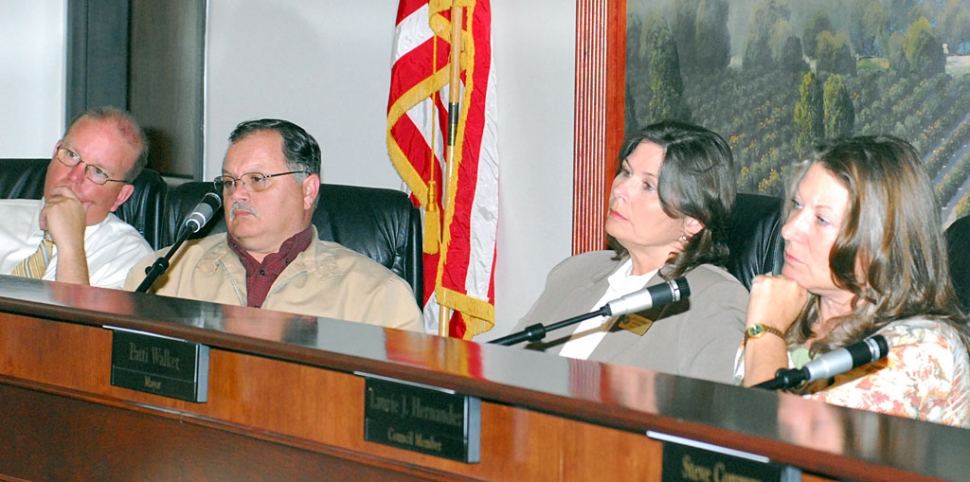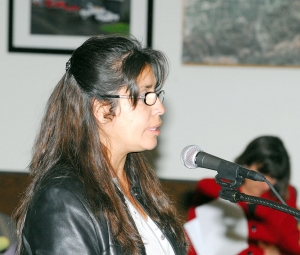|
Measure I addressed
 From left to right: Interim City Manager Bill Bartels, Council members Jamey Brooks, Gayle Washburn and Mayor Patti Walker. The three council members glossed over the possible half-million dollar cost of implementing Measure I, which each promoted last November. By Mariandrea Mueller — Wednesday, March 25th, 2009
 Former councilmember Cecilia Cuevas spoke at Tuesday night’s council meeting. The City Council meeting was well-attended on Tuesday, March 24, 2009. Many were there to comment on the implementation of Measure I. The Council decided to move forward on implementing Measure I, re-named River Park, avoided delays in the Business Park development by providing for Well #9, decided not to purchase property to straighten the B St. extension, and came to an agreement with 4H for use of the Equestrian Center. Police Chief Tim Hagel reported on 2008 Crimes Rates. Crime in Fillmore is down 15% overall from 2007 levels, Hagel reported. There were 2248 arrests and 2493 traffic citations in 2008. Hagel explained that the department's policy of frequent probation searches (targeting violent probationers) is proactively keeping drugs, weapons, and gang members off the streets. The arrest rate for probation searches is 28%. According to Hagel, an unrecorded telephone hotline for reporting gang activity is also reducing crime. He said that the FBI requires reports on significantly serious crimes, and Fillmore's number of crimes reported to the FBI is down 35% compared to 2007. Property crimes are down 11%. Hagel noted that police and fire response times are averaging under 3 minutes, and Fillmore residents seem comfortable calling on and making reports to the police. The Council's discussion about how to implement Measure I began with Community Development Director Kevin McSweeney's presentation on the changes required as a consequence of Measure I. Then the Council heard public comments before voting on a recommended course of action. McSweeney explained that revisions are needed for the General Plan Land Use Element, the North Fillmore Specific Plan (NFSP), the October 2008 Housing Element, the Capital Improvement Program, possibly the Circulation Element (traffic planning), and zoning ordinances. The Environmental Impact Report (EIR) for North Fillmore has been invalidated by Measure I, and either needs to be amended or a new EIR created; the project described in the old EIR is no longer possible, and the project described in Measure I has no EIR. An Initial Study will determine the type of environmental document needed. Because Measure I does not specify how the maximum 350 units are to be distributed throughout the 101 acres in North Fillmore with a maximum density of 5 units per acre, the City must develop a Land Use Map. The Map will also designate locations for the 10-acre park, commercial land use, and civic land use. The City might need to increase sewer fees and rates. The City will have to make plans for adding low- and moderate-income housing elsewhere in Fillmore or attempt to fight State laws concerning the Housing Element. The City plans to hire consultants to assist in revising the above documents, and will hold workshops to receive community input. Before public comments were heard, Mayor Patti Walker requested that the public remain courteous and stay on the topic of implementation rather than debating Measure I itself. Ralph Rees explained the calculations behind the 350 unit maximum, and provided the City with his rough-draft map which could be used to inform the development of a Land Use Map for North Fillmore. Eileen McCarthy, staff attorney at California Rural Legal Assistance, explained that the State has determined through studies that, in order to be affordable, low- or moderate-income housing must have a density of 20 units per acre in Ventura County. To be affordable in Ventura, Thousand Oaks, or Oxnard, there must be 30 units per acre. The only way for housing to be less dense and affordable is if the City finds a way to subsidize residents. Nanette Keller gave a moving speech on the negative impact uncertainty (regarding land-use potential) has had on her small-town business and her employee's families. She has been trying to sell part of her land in North Fillmore for years, but has had difficulty because of changing City plans and conflict in the community regarding land-use. Cecilia Cuevas revisited the October 2008 letter from the California Department Of Housing And Community Development about the potential negative impact of Measure I. She also revisited City Attorney Ted Schneider's 2008 legal analysis of Measure I. Brian Sipes said that the previous Council had heard community opinion but not heeded it, and so Measure I was necessary to lower density in North Fillmore. Gloria Hansen agreed with that. Sipes said Fillmore needs to be creative to overcome the bad economy. Marcos Hernandez believes affordable housing can be located within Fillmore while accommodating Measure I. The only Council Member to bring up the possibility of an election to overturn Measure I was Laurie Hernandez. Steve Conaway declared his intention to uphold "the will of the people" in implementing Measure I. He did mention that building 350 or fewer new units in North Fillmore might not allow the City to break even on property taxes in North Fillmore, so North Fillmore residents' services might need to be subsidized by other Fillmore residents. Conaway and McSweeney expressed concern that sprawl might be created if room for additional units is not found within Fillmore's current boundaries. After Gayle Washburn expressed concern that the public workshops be citizen-driven not consultant-driven, McSweeney said he would elaborate on the community-input requirement in the Request for Proposals (RFP). The Council authorized the City Manager to prepare and distribute an RFP to revise the North Fillmore Specific Plan and prepare an Initial Study with the appropriate environmental document in accordance with Measure I. It also authorized him to contract with Rincon Consultants for up to $2700 to include Measure I language in the General Plan Land Use Element. The Council set a timeline and calendar for developing the 2009-2010 City Budget. The Council voted to allow up to a total of $3000 to be spent on airfare and car rentals for all Transitional City Manager candidates who live over 400 miles away to come to Fillmore for interviews. Tom Scott, from the City Engineering Department, explained to the Council that although the City does not have $2.1 million to complete Well #9 by May 2010, the Well must be completed by that date or major development projects, including the Business Park, would incur a building moratorium and be denied occupancy permits. The Council approved a $750,000 Interfund Anticipation Loan from Redevelopment Agency Bond Proceeds Funds to a Water Development Impact Fee Fund. The money will be used towards planing, designing, drilling, testing, and capping Well #9. That would enable Well #9 to be ready for use by May 2010 on an emergency basis with the rental of pump equipment as needed. The Council approved the formation of Community Facilities District (CFD) No. 8 (Fillmore Business Park), which will be responsible for finding funds to complete the well. The Council found that if Well #9 is available for emergency use as planned, then the building moratorium will not happen. The Council's finding and the formation of the CFD allows Business Park development to proceed. The winner of the park naming contest was Jonathan Richmond with the suggestion of "Two Rivers Park". The Council approved that name, and Richmond will receive a $50 prize. There were 37 entries in the contest, and the Parks Commission recommended the winner. The Council decided to proceed with the B Street extension without purchasing Herb Haase's property because the purchase would cost too much and cause too much of a delay. City Attorney Ted Schneider explained that the purchase would cost the City not only the purchase price, but also redesign costs and additional construction costs for installing a sidewalk, installing lighting, and using concrete instead of asphalt. The City has a $400,000 grant, and constructing a straight street instead of the planned crooked street might cost $530,000. Schneider noted that the purchase would require negotiations and redesign which could significantly delay the project. The project must be completed by April 2010 or the grant will be rescinded. Washburn voted against rejecting the purchase. |
